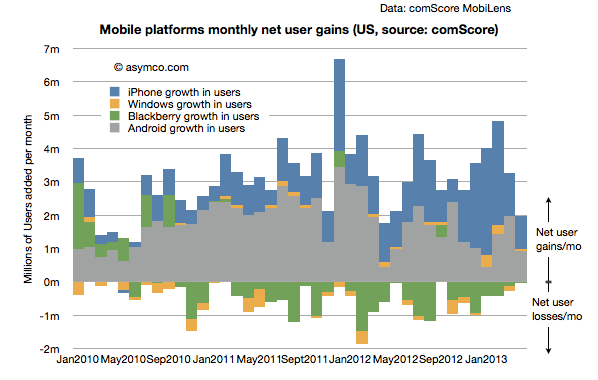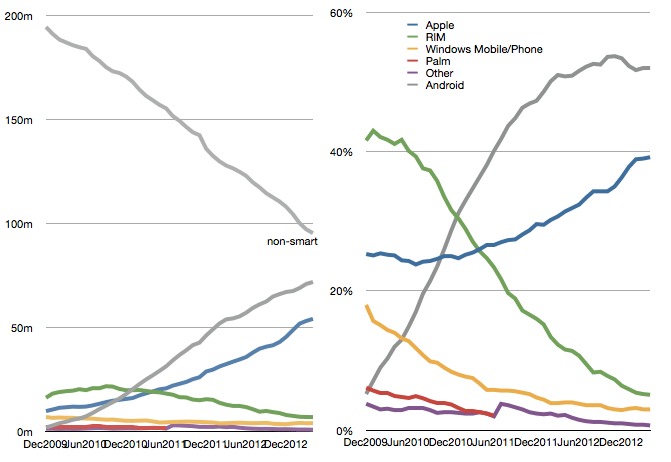Recently, Microsoft announced that they will be rebranding Nokia as Microsoft Mobile. A company that once was a de facto entity in the world of mobile phones, Nokia surely seems to have come full circle. But, while the world is currently busy talking about Nokia, there’s another smartphone brand that has seen better days: BlackBerry.
Alphanumeric pagers, email machines, and smartphones—BlackBerry seems to have done it all. But BlackBerry’s tango with stardom appears to be coming to an end, as the figures don’t looking promising. In this article, I talk about the historic rise and imminent fall of BlackBerry.
Good Days: The Industry Leader
In 1999, BlackBerry came up with its first portable email device. Shortly after, with the introduction of voice capabilities, BlackBerry’s email devices evolved. The idea was quite simple back then: Research in Motion (RIM) realized that instead of receiving a phone number to call back, most users would prefer receiving actual action-worthy information on their devices.
Over a period of time, handsets got better, battery lives improved, and in 2002, the BlackBerry smartphone greeted the world. BlackBerry 5810 was born.
BlackBerry and Nokia then went on to dominate the smartphone space for many years.
The Game Changed
In 2007, 1 out of every 3 smartphones in the USA was a BlackBerry. The trend would continue until 2009—when the bubble burst, and the downward spiral would began.
So, what happened? Apple.

Apple’s iPhone changed the game for everyone. Its touchscreen was an entirely new experience, and with all its flaws, Safari was better than what BlackBerry was offering.
But, it wasn’t Apple’s rise that led to BlackBerry’s fall. It was the denial of Apple’s rise. To quote Jim Balsillie, the then co-CEO of BlackBerry:
“The recent launch of Apple’s iPhone does not pose a threat to Research In Motion Ltd.’s consumer-geared BlackBerry Pearl and simply marks the entry of yet another competitor into the smartphone market.”
In 2008, BlackBerry responded to the Apple threat by presenting its first touchscreen device: the BlackBerry storm. The hardware keypad was gone, creating a more sophisticated look, but the touchscreen implementation was way below standards.
In April 2009, BlackBerry came up with its very own App World—based along the lines of the Apple App Store. Unfortunately, BlackBerry’s app market fell short in their quantity of apps.
BlackBerry Torch was released in 2010. It was a hybrid device, that featured a mediocre hardware keypad and an equally mediocre touchscreen.
The Collapse
Following the failure of Storm and Torch, BlackBerry gave up on its BlackBerry OS, and decided to integrate QNX software into its hardware. The decision was good, but the transition took far too long. Even after a year, BlackBerry didn’t have a device running on the new software. By the end of 2011, there was still no sign of QNX-powered devices, and its US market share had dropped to 16%.
2012 prepared BlackBerry for its doomsday: in spite of a new CEO, no new devices were released, and the only announcements were job cuts. In January 2013, BlackBerry finally came up with Z10. Was it a good phone? Definitely. The interface was improved, and the hardware was solid. Z10 was trying to do what Storm and Torch should have done.
At best, BlackBerry Z10 was good enough to keep existing BlackBerry fans happy. Unfortunately, it wasn’t good enough to threaten competitors.
In the later part of 2013, Fairfax Financial offered BlackBerry a deal worth $4.7 billion for their company. But the deal didn’t work out.
BlackBerry lost the smartphone war, without even putting up a fight. BlackBerry Storm and Torch were just not up smartphone standards, and the 2011-12 hiatus was just too long. The world refused to wait, and sadly, BlackBerry was displaced from the top of smartphone market it helped create.
Where Did All the BlackBerrys Go?
In the past, BlackBerry users made up as much as 40% of the total mobile user base. As of now, they comprise less than 3.4%
The BBM Messaging Platform is being pitched as BlackBerry’s last ray of hope. This particular tool isn’t only BlackBerry’s only present-day offering that can be termed as popular, but it’s also something that’s had a great deal of customer loyalty.
Following the launch of BBM for iOS and Android, BlackBerry acquired 20 million new users of its messaging platform, within a week. This indicates that most BlackBerry users have switched either to iOS or Android—Windows Mobile seems to be nowhere in the picture.

More importantly, talks of replacing BlackBerry were already making the buzz in 2010 itself.

Verdict
While BBM rose to popularity at a terrific rate, its growth rate wasn’t sustainable. Although BBM gained 20 million users in its first week, months down the line many of their accounts became inactive.
What does this mean for BlackBerry? Well, on the bright side, the exodus of users moving away from BlackBerry were mostly teenagers, so the enterprise user base might still be worth saving. But, looking at the bigger picture, unless a WhatsApp-like cash-in happens, BlackBerry should prepare to either re-invent the wheel and seek a twist of fate, or accept the slow yet steady fall from the top.
And lastly, just to put things into perspective, here is data from Google Trends, showing interest in BlackBerry, Apple iOS and Android over time:
Featured Image via Fatoooma Qatar
Are/were you a BlackBerry user? Share your views in the comments below!
 Sufyan bin Uzayr is a freelance writer and Linux enthusiast. He writes for several print magazines as well as technology blogs, and has also authored a book named Sufism: A Brief History. His primary areas of interest include open source, mobile development and web CMS. He is also the Editor of an e-journal named Brave New World. You can visit his website, follow him on Twitter or friend him on Facebook and Google+.
Sufyan bin Uzayr is a freelance writer and Linux enthusiast. He writes for several print magazines as well as technology blogs, and has also authored a book named Sufism: A Brief History. His primary areas of interest include open source, mobile development and web CMS. He is also the Editor of an e-journal named Brave New World. You can visit his website, follow him on Twitter or friend him on Facebook and Google+.


2 Comments